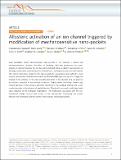Allosteric activation of an ion channel triggered by modification of mechanosensitive nano-pockets
Date
10/10/2019Author
Grant ID
BB/R013780/1
099149/Z/12/Z
RPG-2018-397
Metadata
Show full item recordAbstract
Lipid availability within transmembrane nano-pockets of ion channels is linked with mechanosensation. However, the effect of hindering lipid-chain penetration into nano-pockets on channel structure has not been demonstrated. Here we identify nano-pockets on the large conductance mechanosensitive channel MscL, the high-pressure threshold channel. We restrict lipid-chain access to the nano-pockets by mutagenesis and sulfhydryl modification, and monitor channel conformation by PELDOR/DEER. For a single site located at the entrance of the nano-pockets and distal to the channel pore we generate an allosteric response in the absence of tension. Single-channel recordings reveal a decrease in the pressure activation threshold of the modified channel and a sub-conducting state in the absence of applied tension. Threshold is restored to wild-type levels upon reduction of the sulfhydryl modification. The modification associated with the conformational change restricts lipid access to the nano-pocket, and interrupts the contact between the membrane and the channel that mediates mechanosensitivity.
Citation
Kapsalis , C , Wang , B , El Mkami , H , Pitt , S J , Schnell , J , Smith , T K , Lippiat , J , Bode , B E & Pliotas , C 2019 , ' Allosteric activation of an ion channel triggered by modification of mechanosensitive nano-pockets ' , Nature Communications , vol. 10 , 4619 . https://doi.org/10.1038/s41467-019-12591-x
Publication
Nature Communications
Status
Peer reviewed
ISSN
2041-1723Type
Journal article
Description
C.P. is supported by the Royal Society of Edinburgh. C.P. acknowledges support by Tenovus (T15/41) and Carnegie Trust (OS000256) and the University of St Andrews, the University of Leeds and the Chinese Scholarship Council for the C.K. and B.W. studentships respectively. S.J.P. is supported by the Royal Society of Edinburgh. J.S. acknowledges funding from the MRC (M019152 and L018578). B.E.B. and C.P. acknowledge support by the Leverhulme Trust (RPG-2018-397). This work was supported by Wellcome Trust [099149/Z/12/Z] and BBSRC equipment grants (BB/R013780/1).Collections
Items in the St Andrews Research Repository are protected by copyright, with all rights reserved, unless otherwise indicated.

